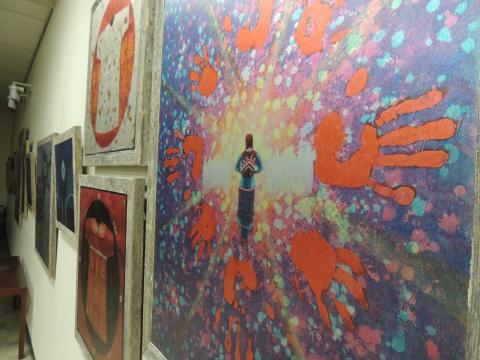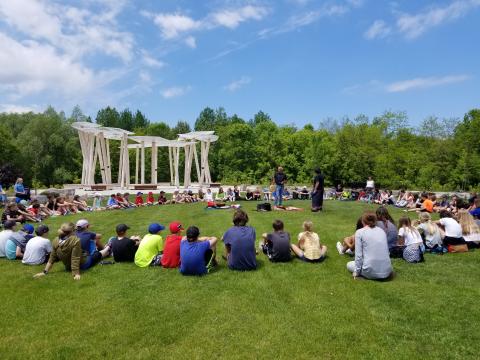
The Town of Collingwood is proud to support arts and cultural initiatives that foster reconciliation, education, and awareness. These opportunities create opportunities for reflection, learning, and connection within the community, which are central to Collingwood’s ongoing efforts to honour Indigenous histories, cultures, and contributions.
Explore Arts & Initiatives
The Teachings of the Seven Grandfathers are an ancient Anishinaabe/Midewiwin teaching on the ethics of proper behaviour and conduct or 'the good way of life'.
Of all the North American Indigenous teachings, the Seven Grandfather Teachings are the most commonly shared and there are many versions. For thousands of years, these teachings were passed down from generation to generation through stories and ceremonies. In his book, Ojibway Heritage, Anishinaabe writer, storyteller, teacher and scholar Basil Johnston, explains that Anishinaabe stories are "flexible in nature and scope and are often best narrated so that the teller can use their skill and imagination to impart any level of meaning for the audience." (p 8) We hope you will imagine listening to a gifted storyteller as you read these traditional teachings of the Anishinaabe people and let your curiosity delve you deeper into learning about their history, culture and lives today. "But it is not enough to listen to or to read or to understand the truths contained in stories; according to the elders the truths must be lived out and become part of the being of a person". (p 7)
The artwork for this page was created by Anishinaabe artist and illustrator, Luke Swinson.
Niizhwaaswi Gmishoomsinaan Kinoomaagewinan - The Seven Grandfather Teachings
Educator, author and spiritual leader, Edward Benton-Banai tells a story of the Seven Grandfathers in The Mishomis Book, The Voice of the Ojibway. "There were Seven Grandfathers who were given the responsibility by the Creator to watch over the Earth's people. They were powerful spirits. The Seven Grandfathers recognized that life was not good for the people. They sent Oshkabaywis (helper) to walk among the people and bring back to them a person who could be taught how to live in harmony with the Creation." (p 60)
Six times the Oshkabaywis tried to find a person worthy enough to bring back to the Seven Grandfathers. Finally, after journeying seven times, Oshkabaywis returned with a baby and the Seven Grandfathers were happy. They instructed the Oshkabaywis to take the baby to every corner of the earth to see all of creation. This took seven years and when they returned, each of the Grandfathers gave the child a gift (Teaching) to share with the people. (p 61-66)
Nbwaakaawin | Wisdom
To cherish knowledge is to know Wisdom. Wisdom is given by the Creator to be used for the good of the people. In the Anishinaabe language, this word expresses not only Wisdom but also prudence or intelligence.
Wisdom is represented by the Beaver who uses its natural gifts wisely in order to survive like cutting logs and branches with its sharp teeth to build lodges and dams.

Aakide’ewin | Bravery
Bravery is to face the foe with integrity. In the Anishinaabe language, this word literally means “state of having a fearless heart.” To do what is right even when the consequences are unpleasant.
Bravery is represented by the Bear. When caring for and protecting her young, the mother Bear has many challenges and she uses her courage and strength to stand up to her fears.

Mnadendimoowin | Respect
To honor all creation is to have Respect. All of creation should be treated with Respect. You must give Respect if you wish to be respected.
Respect is represented by the Buffalo who at one time was a significant resource for Anishinaabe people, giving every part of itself to sustain human life for food, clothing, and shelter.

Debwewin | Truth
To learn the truth, to live with truth, to walk with truth, to speak truth.
Truth is represented by the Turtle. Teaching of the Anishinaabe conveys that the Turtle was here during the creation of Earth and bore the weight of the new world on its back, making life possible. By living in a slow and conscientious manner, the Turtle knows the value of both the journey and the destination. Truth is to know all of these things.

Gwekwaadiziwin | Honesty
Honesty in facing a situation is to be brave. Always be Honest in word and action. Be Honest first with yourself, and you will more easily be able to be Honest with others. In the Anishinaabe language, this word can also mean righteousness.
Honesty is represented by the Raven. The raven knows his gifts and how to use them and accepts himself as he is. He does not look to have the gifts of others such as power or beauty but rather uses his own abilities to the the fullest.

Dbadendizwin | Humility
Humility is to know yourself as a sacred part of Creation. In the Anishinaabe language, this word can also mean compassion. You are equal to others, but you are not better.
Humility is represented by the Wolf. Wolves are social animals that live in packs. Their nature is to seek life-long bonds, work in cooperation with each other, and for the greater good of the pack.

Zaagedowin | Love
To know peace is to know Love. Love must be unconditional. When people are weak they need Love the most. In the Anishinaabe language, this word with the reciprocal theme /idi/ indicates that this form of love is mutual.
Love is represented by the Eagle. Teachings of the Anishinaabe convey that the Eagle represents love and he carries all the teachings. The Eagle can travel over great distances and to great heights, seeing across the four directions and flying nearest to the creator. An Eagle feather is considered a high honour and a sacred gift.

About the Artist
Luke Swinson is an illustrator and muralist who grew up in Collingwood and currently lives in Kitchener, Ontario. A member of the Mississaugas of Scugog Island First Nation, Luke's work reflects his desire to better understand and reclaim his Indigenous culture. He seeks to promote cultural education and preservation through his art projects.
Having been raised around computers, Luke is primarily a digital artist and enjoys using non-traditional methods to express himself creatively. He is mostly self-taught but has been mentored and encouraged by his Father. Luke uses flowing lines and bold colours to convey the spirit and life of the subjects he illustrates. He is inspired by current and past Indigenous artists, the Ontario landscape, and the wildlife that inhabits it. @LukeSwinsonArt

Cultural content:
Descriptions of the Teachings were provided by Dr. Duke Redbird, an Indigenous poet, painter, broadcaster, filmmaker, and speaker.
Information in italics about how each animal embodies the Teaching was sourced or cited from Anishinaabeg Bimaadiziwin: An Ojibwe Peoples Resource, Obijwe Teachings, 01/12/2021.
Indigenous Veterans Day is observed in Canada on November 8, a day in honour of First Nations, Inuit and Metis for their military service during times of war, conflict and peace with commitment, courage and excellence.
Throughout our history, Indigenous veterans have risked their lives to defend and protect our fundamental freedoms. We owe our deepest gratitude for their bravery, sacrifice and service.
The legacy of our colonial history and racism has meant that First Nations, Inuit and Metis people have had to fight for recognition and equal treatment, including on Remembrance Day.
More Resources:
Indigenous veterans: They fought for freedom, democracy and equality 'they could never share'
Government of Canada Veterans Affairs
Indigenous Veterans: From Memories of Injustice to Lasting Recognition
The Town is committed to inviting Indigenous teachers and Elders to the Awen' Gathering Place to engage the public in discussions and education focused on traditional Indigenous land-based learning.
A three-part ceremony and discussion series called the Niibi Gatherings brought community members to the Awen' to learn about the sacred connection to the spirit of niibi (water) shared by women in Anishinaabekwe culture as protectors and nurturers of water, to hear about the heritage of Chippewas of Nawash fishing families and to partcipate in a community art project reflecting on our personal history and heritage and the land to which we feel most connected.
The Niibi Gatherings took place on the ceremonial lawn adjacent to the pavillion with perimeter stone seating, focused on a central presentation space and future fire pit.

On National Day for Truth & Reconciliation, an installation of the poem A Tribute to Our Stolen Spirits by Jillian Morris, Kanien’kehá:ka, Six Nations was permanently located at the Awen’ Gathering Place. Below is a recording of Jillian reciting her poem.
The Truth and Reconciliation Commission of Canada Call to Action # 83 calls upon artists and the community to collaborate and create projects that contribute to the reconciliation process.
Inspired by this Call to Action, eight indigenous and eight non-indigenous artists embarked on a quest for truth and reconciliation through sharing, learning and collaboration. The result is a linked series of artworks that honestly and respectfully reflects past experiences while envisioning a future toward reconciliation.
In the spirit of reconciliation, the Town of Collingwood showcased aluminum versions of the Call to Action #83 artwork series in Council Chambers and invited the public to view the panels.
To kick off the display, an event was held at the Simcoe Street Theatre called Envisioning A Future Toward Reconciliation at which Project Curator, Mary Louise Meiers led a presentation and reflection with artists Peter Adams and Paul Shilling and presiding elders Jeff Monague, Myiingan, former Chief of Beausoleil First Nation and Austin Clarkson, Director, The Milkweed Collective.
The Healing Dress-Missing by Jennie Clark:

End of Oppression by Paul Shilling Dazaungee:
